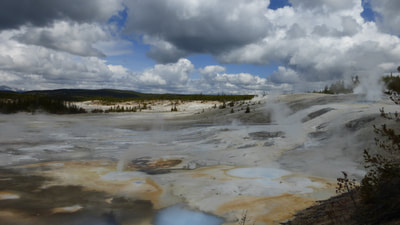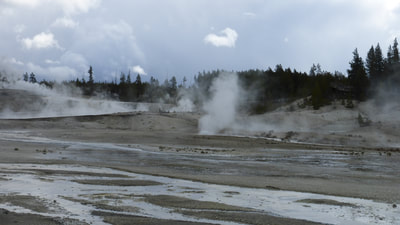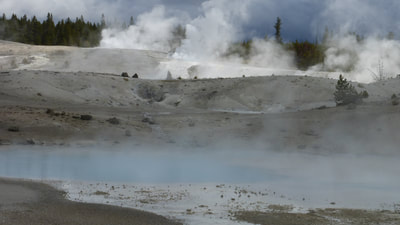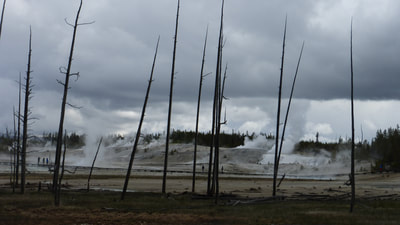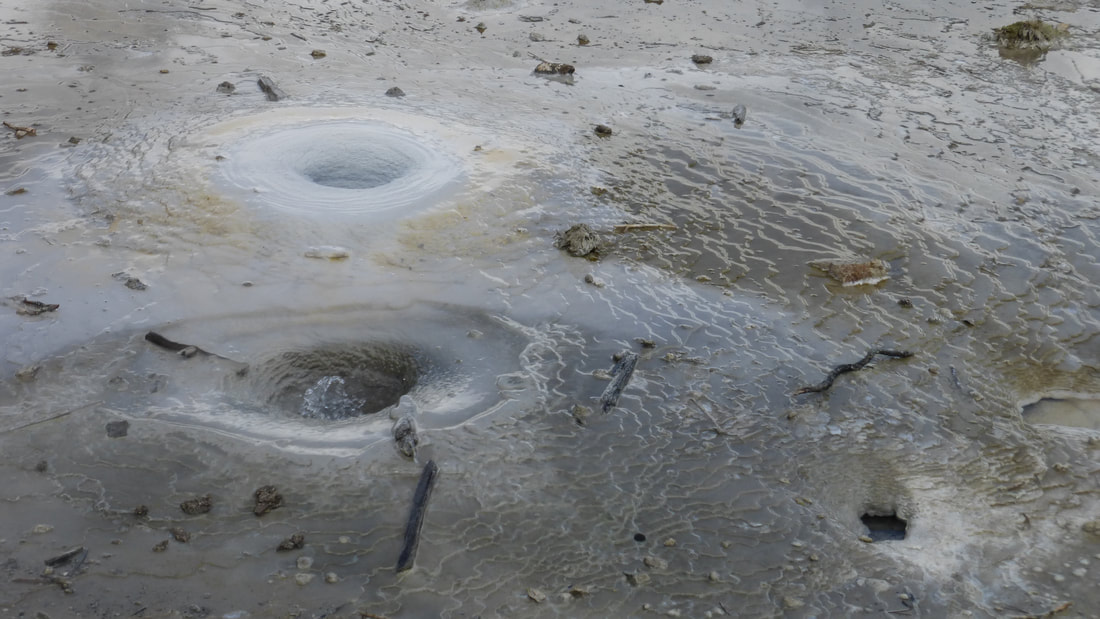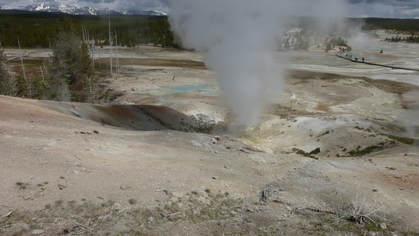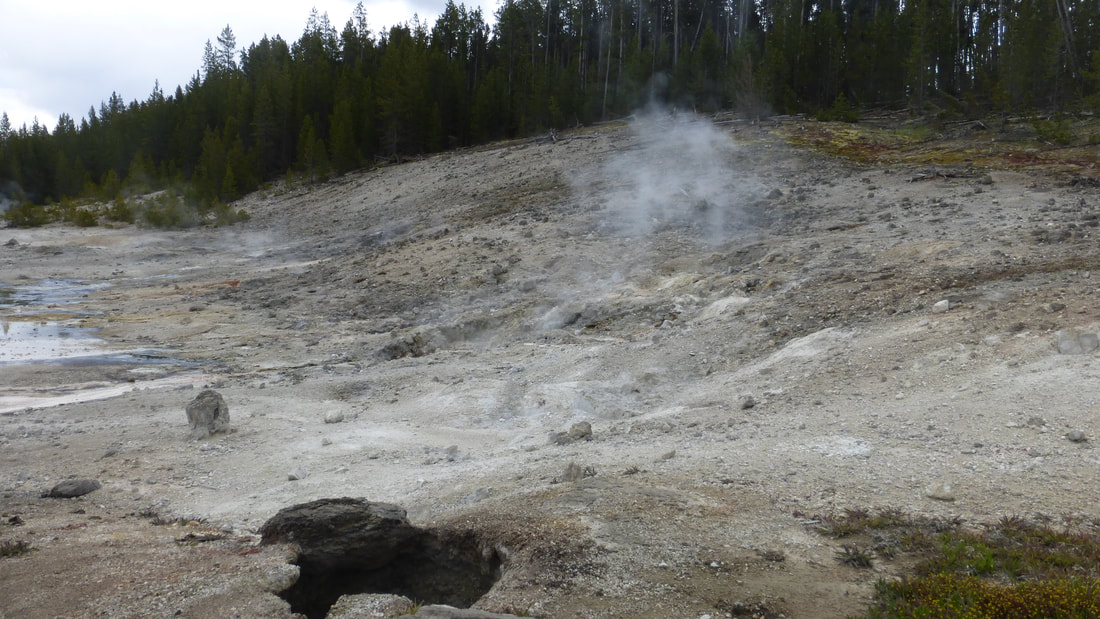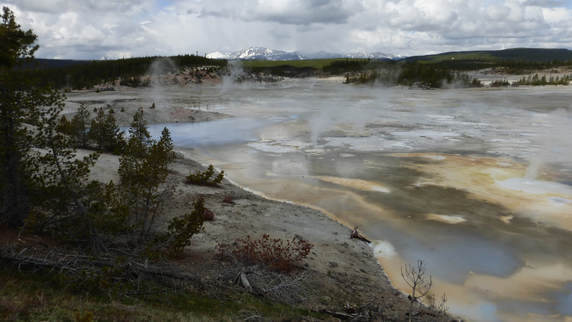In a valley between forested hills is a rolling, barren, white and gray plain, marked by sporadic clouds of steam rising to the sky. The ground is crusted with mineral deposits between scattered thermal pools and geyser mouths. Many trees on the margin of the plain are dead, some with bleached trunks.
Dimensions This irregularly-shaped basin ranges from half a mile to more than a mile (1-3 km) across. The ground gently rises and falls by tens of feet (many meters). While some pools of thermal water are many yards/meters across, the craters of geyser mouths are generally quite small, less than five feet (1.5 m) across.
Key Details
- Some geyser mouths are flush to the ground, or even in depressed basins, while others are in elevated, anthill-like mounds or even irregular chimneys of hard mineral deposits.
- At any given instant, just a few geysers are erupting across the basin. While many geysers erupt unpredictably, some have quite regular schedules, their eruptions repeating over a set number of minutes or hours.
- Steam activity and water levels in geyser mouths rise and fall in complex ways between eruptions. Warning signs that an eruption is building may include hissing and splashing noises, but these can persist for many minutes beforehand, making the eventual spout of water and steam still a surprise. Adjacent geysers may be linked in their behavior, so that one's rapid change in water level or activity may be signal of an approaching eruption in the other.
- Water and steam blasting up from a geyser mouth is super-heated and highly dangerous. Once the water tossed into the air is falling back to the ground, it has had chance to cool and may be only uncomfortably hot or lukewarm. Yet this shower of water, often directed to one side of the geyser by wind or angle of the geyser throat, can still temporarily block sight of surroundings. The mineral-charged water also makes deposits (frosting) on eyeglasses and camera lenses.
- In addition to sporadic mist from geyser activity, clouds of warm water vapor rising continually from thermal pools can obscure part of the view, subject to shifting winds. Vapors here smell of sulfur, and the mineral-charged water has an acidic tang.
- Thermal pool and geyser mouth waters in this basin are typically right at the boiling point, inhospitable to any form of life, showing no colors other than white and gray. A few pools and more distant paths of surface water drainage from the geysers show some bright yellows, oranges, and greens from bacteria (cyanobacteria) and algae that can tolerate somewhat cooler water.
- There are also fumaroles scattered across this basin: small openings jetting out superheated steam. Hard to locate visually, these dangerous features are most obvious to the ear, emitting constant hissing or even light roaring sounds.
- Every year this area has a number of mild earthquakes that can be felt by a visitor. Rare ones will have ground shaking that could knock people off their feet; many more will be light tremors at the edge of perception. These are cause by movements of still-molten rock deep below the ground surface in this dormant volcanic area. Geysers can permanently alter their activity when an earthquake opens up new fractures underground.
Story Elements
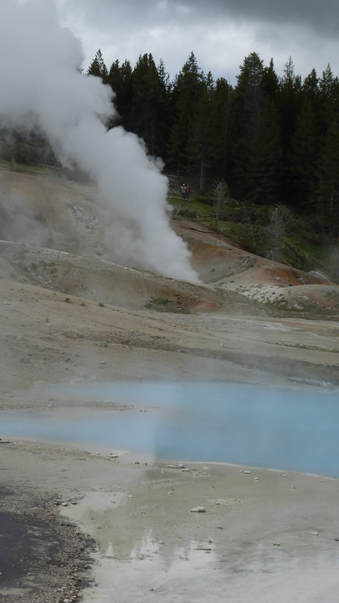
- This might be a place to collect unusual mineral compounds and geyser water (which will leave a mineral coating inside a glass container after cooling).
- An alien scene like this could be an end-of-quest location for a long mountain woodland journey, or a milestone setting for unexpected realizations.
- Unwary travelers will have difficulty crossing the geyser basin. In some spots the mineral crust caking the ground can give way underfoot, opening to shallow cavities of steam and scalding water. The safest policy to avoid these is to follow foot trails of other people or large animals, areas of scrub grass, or margins of the basin. Some means of broadly distributing weight (a movable board, snowshoes) would help in a pinch.
- Someone staying at the site for a while would become familiar with the regular eruptions, as well as the relative amount of activity from other geyser mouths, and be able to use this to advantage in encounters with new arrivals.
- Possessions, in addition to explorers, could be damaged by boiling water and/or steam. Alternatively, if caution is used, the basin's warm mists might succor chilled winter travelers, and fumaroles can be cooking sites. There are even stories in the area of tourists laundering handkerchiefs by dropping them into one geyser mouth and having them shoot out with another geyser nearby.
- In battle, the temporary, shifting eruptions of geysers may cause advantage/disadvantage of position and visibility to shift around as well.
- Clues that a character has been in the basin recently include the smell of sulfur, scald marks, mineral crust on boots soles and belongings, and mineral coating on glass possessions.
- What might happen if characters enter mostly cooled water from this area, in the story setting - cleansing/healing, transformation/enhancement?
- Apparently safer trails near/among the geysers might be locations for traps or hidden predators.
- This area might well be seen as a place to avoid or view only from the margins. Motivation to enter might be provided by a precious object or person stranded within the basin, a famished hunter's pursuit of quarry, a prior directive to enter as part of larger quest, or deliberate choice of this ground for a fight.
Reference Location
Norris Geyser Basin in Yellowstone National Park, Wyoming. This basin has the highest water temperatures in the park, is most seismically active, and shows the most changeable geyser activity.
© Rice-Snows 2017
Proudly powered by Weebly
